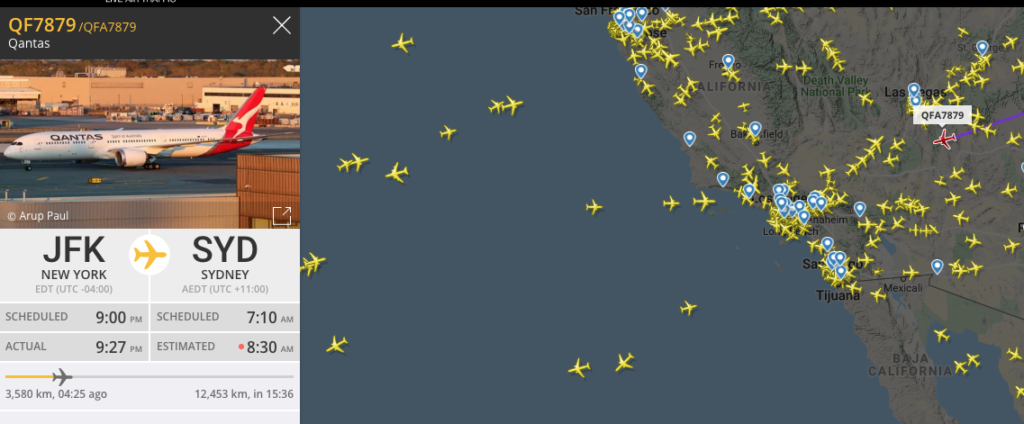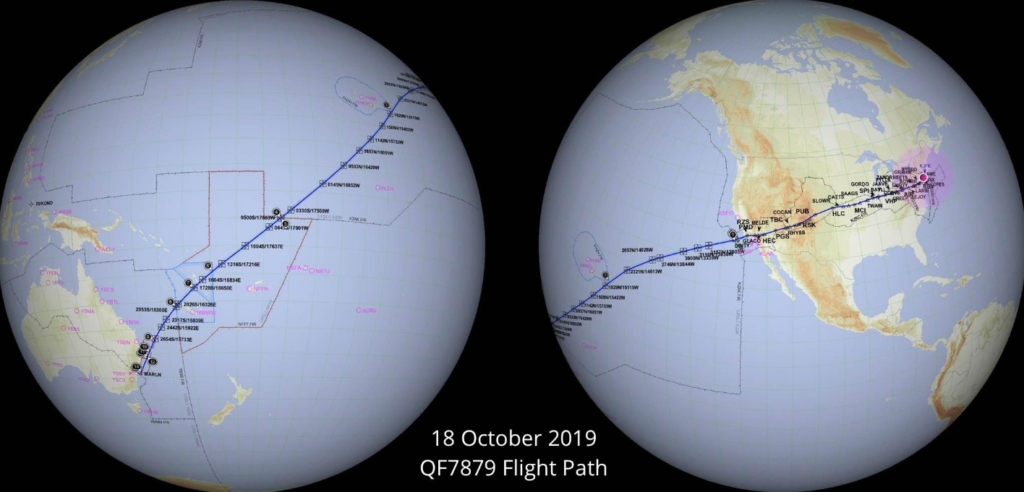Qantas QF7879 New York to Sydney
Qantas QF7879: An historic flight, non-stop from New York to Sydney is underway.
The flight, part of the ambitious Qantas ‘Project Sunrise’ program, is the longest non-stop commercial airline attempt in history.
Image: QF7879 over the USA

The Historic Flight
The flight will take about 50 passengers and crew on a gruelling 20-hour flight in the air from the Big Apple from the Atlantic Ocean at New York to Sydney in the south Pacific Ocean – an incredible attempt for the history books.
The Qantas QF7879 departed New York JFK Airport at around 9.30pm local time. The 16,013 km flight is set to land just before 9AM Sunday morning in Sydney.
This is the first of 3 test fights between Sydney and New York by Qantas.
According to Flight Radar, who had a representative on the epic flight, QF7870 took off with 233,000 kg, close to the 787-9’s max takeoff weight of 254,000 kg.
About 100,000 kg of that is fuel for the epic journey across the North American continent and onward south-west toward the Pacific and finally to Australia.
Image: Flight Path of Qantas Flight QF7870 from New York to Sydney

Flight of Science
Along with select media, the flight is a test of human endurance in long-haul travel.
Scientists and researchers from the Cooperative Research Centre for Alertness, Safety and Productivity (Alertness CRC) and Sydney University’s Charles Perkins Centre, will all be undertaking tests and monitoring passengers.
The teams will be looking at how pilots and crew react to the extreme time and distance in the air.
Researchers on the Qantas flight will be monitoring the brain activity of pilots, alertness levels, sleep and many other factors.
Passengers will also be monitored.
Long-Haul Flight Strategy
The airline will seek to implement strategies for passengers on ultra-long haul flights, including a London to Sydney direct flight, to ensure maximum safety and comfort.
If all goes to plan, Qantas hopes to have direct flights between Sydney and New York, and Sydney to London by 2022.
Fort these fights, Qantas is using Boeing 787-9 Dreamliners for the test routes, which can cut 20% on fuel consumption compared to other airlines.
Qantas also has its own enterprise software system for optimising fuel consumption in flight. The system undertakes real-time mapping of routes and recommends pilot course changes.
This takes advantage of jet streams or to avoid storms and winds that could result in less fuel efficient flights.
The target market for these flights are business travellers, seeking to cut time spent between other ports like LAX or Singapore. Qantas typically takes passengers to those destinations from Sydney currently, with stops in SE Asia the US west coast.
The historic flight will land in Sydney to calm and fine conditions, around 19C and sunny on Sunday morning.
Qantas News Update on the historic flight
The 787-9 aircraft has been positioned to New York after being delivered from the Boeing factory in Seattle. After the research flight is complete, it will enter normal commercial service with Qantas.
The purpose of the record-breaking flight is to conduct scientific research on passengers and crew on an ultra-long haul flight, with the aim of increasing health and wellness, minimising jetlag and identifying optimum crew rest and work periods.
It is part of Qantas’ ongoing quest to launch commercial flights between the east coast of Australia (Sydney, Melbourne and Brisbane) and New York and London. The direct flights would save passengers up to four hours in total travel time and follow the successful Perth-London route, which started in March 2018 and is the only direct link between Australia and Europe.
While not designed for the 16,200 kilometre (10,200 mile) journey from New York to Sydney, the 787-9 being used for today’s research flight will take off with maximum fuel and a restricted passenger and baggage load (and no cargo) to allow the aircraft to operate the flight non-stop. All carbon emissions from this flight, and two additional research flights from New York and London to Sydney in November and December, will be offset.
Airbus and Boeing have pitched aircraft (the A350 and 777X respectively) with the range to operate Project Sunrise flights on a commercial basis. These pitches, together with findings from the research flights and other streams of work, will form part of a business case being developed by Qantas to inform a final yes/no decision on Project Sunrise expected by the end of this year. If approved, flights would start in 2022/23.
Qantas has named its endeavor “Project Sunrise” after the airline’s historic ‘Double Sunrise’ endurance flights during the Second World War, which remained airborne long enough to see two sunrises.
The Qantas dreamliner is already used on the Perth to London direct flight, that takes around 17hours between Australia and the UK
Our newest #QantasDreamliner featuring our Centenary livery has arrived! pic.twitter.com/AX0hpTTk7v
— Qantas (@Qantas) October 15, 2019
Our earlier stories : Qantas Sydney to London flight coming & Qantas preparing for ultra-long haul flights.

